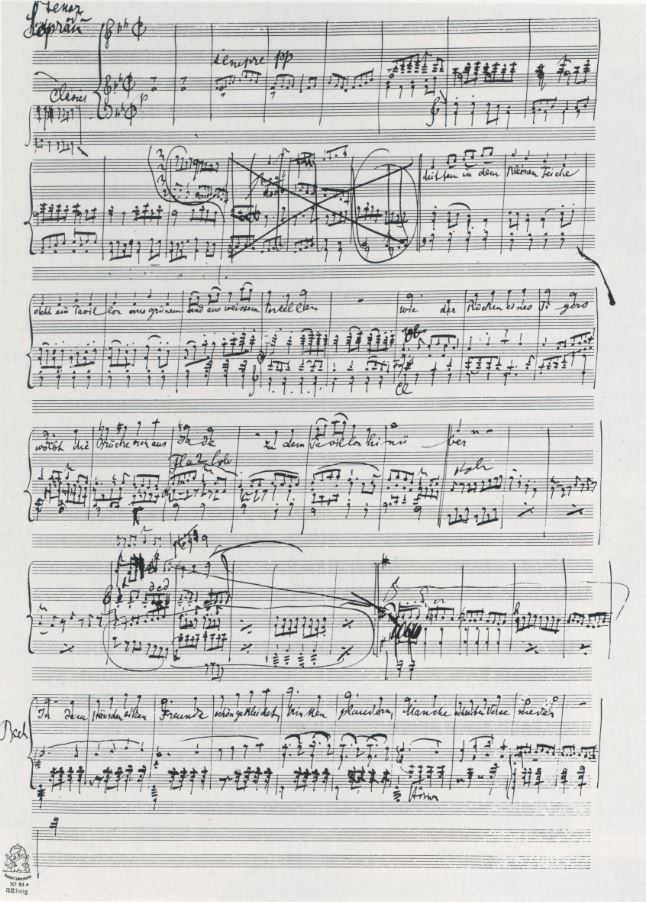Lied 6: Der Abschied

The farewell Der Abschied. Key: C minor to C Major. Schwer. (Heavy). After Chinese poets: Mong Kao Yen and Wang Sei. Voice: Alto (or Baritone). Solo: Mandolin, harp, celesta. Duration: 31 minutes. The final movement is nearly as long as the previous five movements combined. Its text is drawn from two different poems, both involving […]
Lied 5: Der Trunkene im Fruhling
The drunk man in spring Der Trunkene im Fruhling. Key: A Major. Second scherzo. Allegro. Keck, aber nicht zu schnell. (Audacious, but not too fast.) After Chinese poet: Li Bai. Voice: Tenor. Solo: Violin and flute. Duration: 4 minutes. The second scherzo of the work is provided by the fifth movement. Like the first, it opens […]
Lied 4: Von der Schonheit

Of beauty The music of this movement is mostly soft and legato, meditating on the image of some ‘young girls picking lotus flowers at the riverbank’. Later in the movement there is a louder, more articulated section in the brass as the young men ride by on their horses. There is a long orchestral postlude […]
Lied 3: Von der Jugend

Of youth Von der Jugend. Key: B-flat Major. First scherzo. Behaglich heiter. (Comfortably cheerful.) After Chinese poet: Li Bai. Voice: Tenor. Duration: 3 minutes. The third movement is the most obviously pentatonic and faux-Asian. The form is ternary, the third part being a greatly abbreviated revision of the first. It is also the shortest of the six […]
Lied 2: Der Einsame im Herbst

The lonely man in autumn Der Einsame im Herbst. Key: d minor. Etwas schleppend. Ermudet. (Somewhat dragging. Weary.) After Chinese poet: Qian Qi. Voice: Alto (or Baritone). Solo: Windinstruments. Duration: 10 minutes. This movement is a much softer, less turbulent movement. Marked ‘somewhat dragging and exhausted’, it begins with a repetitive shuffling in the strings, followed […]
Lied 1: Das Trinklied vom Jammer der Erde

Drinking song of the world’s misery Das Trinklied vom Jammer der Erde. Key: a minor. Allegro pesante. (Cheerful heavy.) After Chinese poet: Li Bai. Voice: Tenor. Duration: 8 minutes. The first movement continually returns to the refrain, Dunkel ist das Leben, ist der Tod (literally, ‘Dark is life, is death’), which is pitched a semitone higher on […]
Movement 2: Lied 2: Schlussszene aus Goethe’s Faust
Part II: Closing scene from Goethe’s Faust The second part of the symphony follows the narrative of the final stages in Goethe’s poem-the journey of Faust’s soul, rescued from the clutches of Mephistopheles, on to its final ascent into heaven. Movement 2: Lied 2: Schlussszene aus Goethe’s Faust. Movement 2: Lied 2: Schlussszene aus Goethe’s […]
Movement 1: Lied 1: Hymnus: Veni Creator Spiritus
Veni Creator Spiritus (“Come Creator Spirit”) is a hymn believed to have been written by Rabanus Maurus in the 9th century. When the original Latin text is used, it is normally sung in Gregorian Chant. As an invocation of the Holy Spirit, in the practice of the Roman Catholic Church it is sung during the […]
Movement 5: Rondo-Finale
Finale. C Major. Boisterous timpani joined by blazing brass set the scene for the riotous fifth movement. The long, arduous first movement, after three shorter movements developmental in mood, is finally equalled by a substantial ‘daylight’ finale. The movement is a rondo combined with a set of eight variations, capped off by a dramatic coda. […]
Movement 4: Nachtmusik. Andante amoroso
Nachtmusik II. F major. The fourth movement (the second ‘Nachtmusik’) contrasts with the first in that it illustrates a more intimate and ‘human’ scene. With its ‘amoroso’ marking and reduced orchestration (trombones, tuba and trumpets are silent and the woodwinds are reduced by half) this movement has been described as ‘a long stretch of chamber […]
